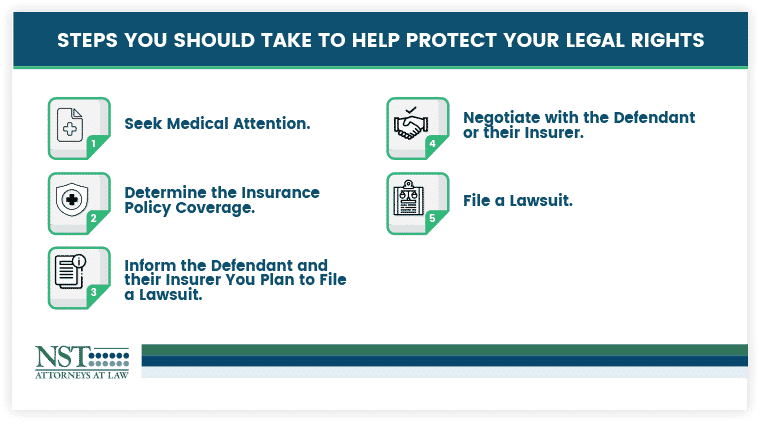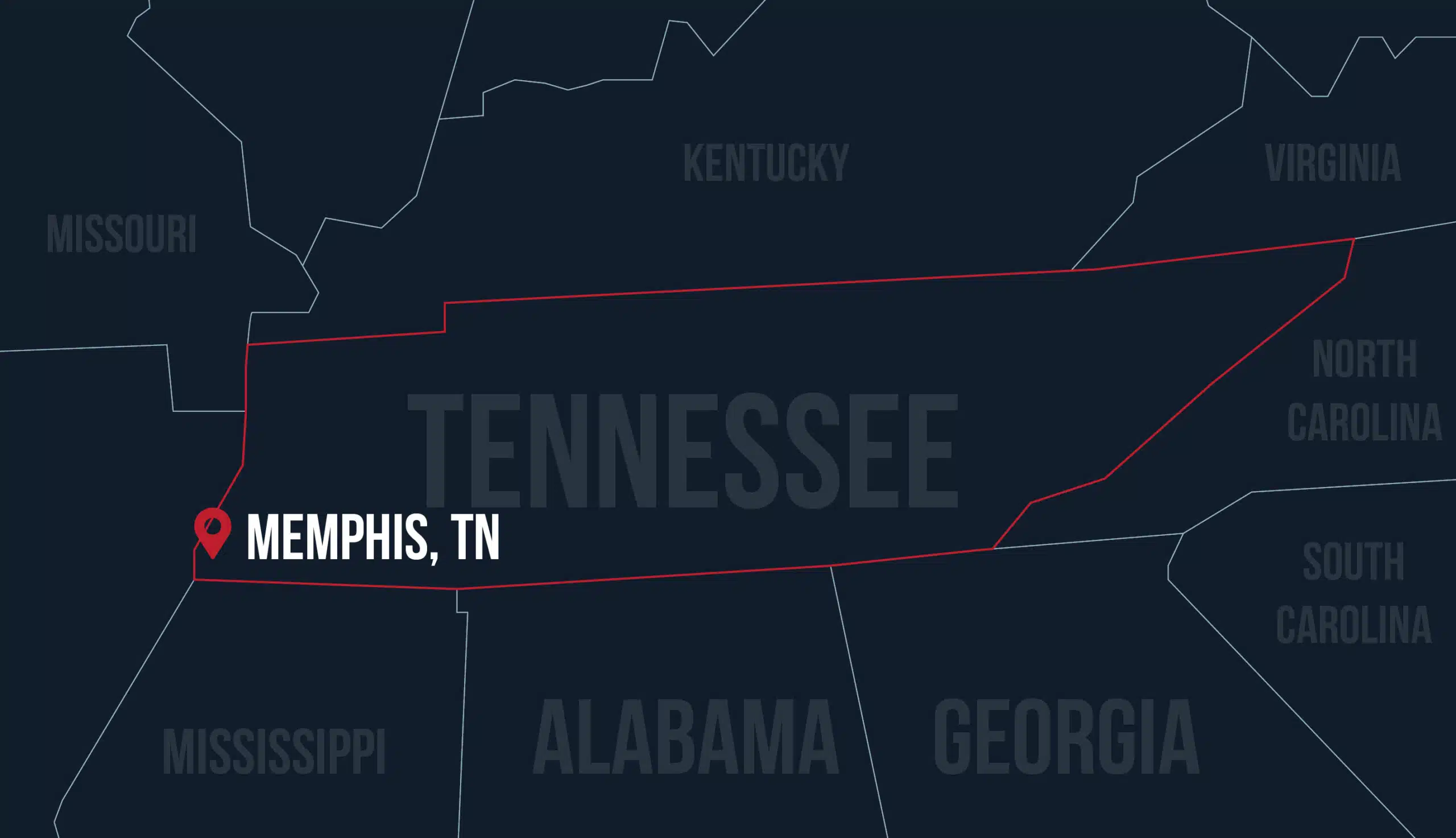
Memphis Personal Injury Lawyers

At NST Law, we are dedicated to helping injured individuals and their families get the justice and compensation they deserve.


Expertise
Mr. Trotz has handled injury cases involving auto accidents, slip and fall, premises liability, and negligent security. Every day, Mr. Trotz represents those who have been injured and many of his clients have sustained traumatic and life-altering injuries.
Table Of Contents
- Why NST Law?
- Hiring a Personal Injury Attorney
- Memphis Client Testimonials
- Personal Injury Practice Areas
- Memphis Accident Statistics
- Memphis Personal Injury Laws
- Process of Filing a Claim
- Statute of Limitations for Personal Injury
- Personal Injury Claim Timeline
- Memphis Accident Victim Damages
- Memphis Injury Case Value
- Evidence to Prove Injuries
- Memphis Personal Injury Lawyer Fees
- Benefits of a Memphis Personal Injury Lawyer
- Steps to Take After an Accident
- When to Call a Memphis Lawyer
- Our Memphis Personal Injury Lawyers
- Our NST Law Memphis Locations
Why You Should Call Nahon, Saharovich & Trotz After Your Memphis, Tn Accident
When you choose our personal injury law firm, you’ll get an award-winning, nationally recognized team of attorneys and support staff fighting for you.
- Our law firm has been a passionate advocate for Memphis accident victims for over 35 years.
- We have over 175 lawyers and staff and serve clients in Tennessee, Arkansas, Mississippi, Missouri, Kentucky, Illinois, and across the entire nation.
- Our attorneys have been recognized as Super Lawyers, Top 100 Trial Lawyers by the American Trial Lawyers Association, Power Players by Inside Memphis Business Quarterly Magazine, Top 50 Lawyers in Memphis, Mid-South Rising Stars, and other high honors in the legal field.
- We’ve won billions for accident victims like you
- We’re invested in our Memphis community, and giving back through local charities and community service is always a priority.
- Client satisfaction is second-to-none, with our attorneys receiving perfect 10 ratings on Avvo and Justia.
At Nahon, Saharovich & Trotz, we’re Champions for the Injured and have been since our founding back in 1990. We offer compassionate, individualized representation to each of our clients, yet still have the resources and power to match those of powerful insurance companies and adversaries.
Contact our law office in Memphis, Tennessee to learn more about how we can help you get through this difficult time. We offer a free, no-obligation case evaluation and are ready to schedule yours today.
Were you recently injured in an accident in Memphis, Tennessee? You may be entitled to compensation for the costs of treatment, loss of income, and the pain and suffering you’ve experienced. However, getting the money you deserve can be a challenge – and that’s where the award-winning Memphis personal injury lawyers at Nahon, Saharovich & Trotz can help.
Since 1990, our personal injury law firm has been standing up to insurance companies, trucking companies, hospitals, and other tough adversaries on behalf of injury victims and grieving families across the state of Tennessee. That’s the NST Way.
We’ve won over $2 billion in benefits, settlements, and verdicts in cases involving car accidents, truck accidents, motorcycle accidents, medical malpractice, slip and fall accidents, wrongful death, and more.
Don’t let a negligent truck driver or another at-fault company off the hook for your life-changing injuries. Let the champions for the injured at Nahon, Saharovich & Trotz fight to hold them accountable for the damage they’ve done. Call our personal injury law office in Memphis, TN, to discover how we can not only help you win your case, but maximize your financial recovery.
Your first consultation is free, so contact us to get started today.
Why Do I Need a Personal Injury Lawyer After an Accident in Memphis, TN?
Insurance companies handle personal injury claims every day. They have teams of experienced defense attorneys and insurance adjusters ready to find a reason to deny your claim or limit your payout. The best way to level the playing field is by hiring an experienced personal injury attorney in Memphis to represent you.
Here’s why:
- You’re more likely to win and maximize your financial award. Studies suggest that victims who hire lawyers tend to win their cases more often and recover more in compensation than those who don’t.
- You’re probably going to be blamed. Victim-blaming strategies are all too common in personal injury cases. Under Tennessee state law, sharing blame will affect how much money you can get after an accident. Under the pure comparative fault system, damages are reduced based on your share of the blame. An attorney will be ready to counter these efforts and work to defend you every step of the way. The less fault you’re assigned, the more money you’ll potentially get in a settlement or verdict.
- You’ll benefit from the law firm’s experts and resources. Expert testimony can make or break a personal injury case. Specialist opinions can be critical in establishing liability and identifying what different damages are worth. Insurance companies will have experts working for them. When you hire a lawyer, you’ll benefit from the firm’s vast resources and ability to retain qualified accident and injury experts in the Memphis area and nationwide.
- You’re not sure what your personal injury case is worth. It can be difficult to know, and you certainly don’t want the trucking company or insurance provider to have to final say. Your personal injury lawyer will work hard to ensure that your case is valued correctly and that your financial award accurately reflects the true cost of your injuries and suffering.
Finally, you deserve time to rest and recover after you suffer catastrophic injuries in a Memphis-area accident. The more time you have to dedicate to your physical health and mental well-being, the better the odds of you making a full recovery. When you hire a Memphis personal injury attorney, you’ll give yourself that opportunity. Your lawyer will handle your case from start to finish while you take the time you need to get better.
However, it’s not just about hiring any accident attorney in Memphis, Tennessee. You need to make sure that you hire the attorney (and law firm) that is best suited to represent you and handle your specific case. After all, you’ll only get one opportunity to seek the compensation you deserve. You’ll want to ensure that you have the best attorney at the helm.
Testimonials from Our Memphis Clients
I received excellent service, Parker Trotz was very thorough and went the extra mile to make sure all my needs were met. Definitely would recommend NST Law if you are ever in need of personal injury firm.
NST made my personal injury claim super easy. I got the medical care I needed and got a settlement for my pain and suffering. The customer service was great.
What Do Memphis Personal Injury Lawyers Do?
Personal injury attorneys are civil litigators who advocate for their clients’ (i.e., the injured parties’) legal rights. Your personal injury attorney can deal with the court and opposing counsel on your behalf, handling the following:
An attorney can help evaluate your case to know if you have a valid compensation claim. They can also present you with your best options to pursue remedies and your chance of a successful outcome with whichever scenario you choose.
Your attorney can decide what claims to present to the court to ensure a positive outcome.
Attorneys know case law and statutes relevant to your injury lawsuit. Attorneys have adequate training and knowledge to find the needed answers if presented with a complex or unique issue.
Your attorney can inform you of the documents you need to compile for evidentiary support of your claim, such as medical bills, employment records, doctor’s notes, medication or other product labels, etc. If you’re having trouble retrieving certain records (e.g., police reports, driving histories, insurance cards, hospital notes or treatment directives, etc.), your attorney can help obtain them.
Your attorney knows what documents to prepare, what arguments to assert, and where to file your claim and initiate your lawsuit. Your attorney will also be aware of court rules and proper procedures to ensure service of process and other legal requirements and standards are followed and accurate to avoid delaying your case or risking the judge dismissing your claim due to a minuscule and preventable error.
Attorneys spend a fair amount of time on a case collecting facts and information relevant to and supportive of your claim. Your attorney can use different discovery requests, including requests for production, interrogatories, admissions, depositions, and third-party subpoenas to obtain the evidence needed to help ensure a satisfactory outcome.
Your personal injury attorney can prepare a complaint to start your lawsuit. Additionally, your lawyer will know what documents to prepare and file to defend motions, conduct discovery, respond to court directives, and make requests from the court or opposing counsel. They also know what supporting laws and legal standards to include in the different documents.
At any point throughout your lawsuit, you can settle with the opposing party or parties and the insurance companies. Your attorney can help guide these discussions and negotiate on your behalf for fair compensation.
If your case doesn’t settle, you’ll need to proceed to trial. Each side will have to assert their arguments and defenses and present evidence of their claims. Your attorney can be your voice in court while following courtroom procedures, evidentiary rules, and other necessary legal protocols and practices.
In summary, your personal injury attorney’s job is to navigate an often complex and convoluted legal system to help you receive the compensation and justice you deserve after being wrongly or negligently injured by someone else.
We Handle All Types of Personal Injury Cases in Memphis
Car Accidents
- Car crashes are one of the most common types of personal injuries, with an average of 23 serious injury wrecks a day in Shelby County in 2022. Our car accident lawyers in Memphis have over three decades of experience helping crash victims like you get the maximum compensation possible.
Truck Accidents
- Memphis is home to several Primary Highway Freight System Routes and is considered a major freight corridor. Our Memphis, TN truck accident lawyers have experience with the specific regulations that apply to truck drivers and trucking companies. We will fight on your behalf to hold at-fault parties responsible for your injuries and losses after a truck crash.
Motorcycle Accidents
- Shelby County ranked number two in Tennessee for the most motorcycle crashes in 2022, with 251. At NST Law, our Memphis motorcycle accident lawyers understand how devastating these kinds of crashes are and will use our experience and resources to get you the compensation you need for your recovery.
Bus Accidents
- Two of the most common reasons our bus accident attorneys in Memphis see for bus crashes are distracted driving and mechanical failure due to inadequate maintenance. As we build your case, we will investigate the cause of your crash and identify all potentially liable parties as we fight for your right to a fair settlement.
Pedestrian Accidents
- Shelby County had more than 450 pedestrian injuries and 62 pedestrian fatalities in 2021. In many instances, pedestrian accidents result in severe injuries that can impact victims long into the future. Our Memphis, TN pedestrian accident attorneys can help ensure you get fair compensation for your recovery now and in the future.
Bicycle Accidents
- Although Memphis has improved bike infrastructure over the years, in 2021, Shelby County had the highest rate of bicycle accident injuries and fatalities in Tennessee. At NST Law, our bicycle accident lawyers in Memphis can help with your case every step of the way so you can focus on your recovery.
Social Security Disability
- In many cases, The Social Security Administration (SSA) will deny initial claims for Social Security Disability. At NST Law, we know that you depend on SSA benefits when you cannot work. Our Memphis Social Security disability attorneys can help you with your initial application or if you need help after a denial.
Workers' Compensation
- As Tennessee continues to pay injured workers fewer benefits, knowing your rights regarding the workers’ compensation system is essential. At NST Law, our Memphis workers’ compensation lawyers are here to help you at every step of the process to ensure you get the benefits you’re entitled to.
Medical Malpractice
- Even at the best hospitals in Memphis, medical providers can put patients at risk due to negligent care. When a health care professional is not as careful as they should be, our medical malpractice lawyers in Memphis are here to help. We can explain your legal options, ensure you meet all deadlines, and fight for the compensation you deserve.
Product Liability
- Our skilled Memphis product liability attorneys believe consumers have a right to information and adequate warnings when they use a product. Unfortunately, countless people in Memphis are injured due to unsafe products every year. We can help you hold manufacturers, suppliers, and retailers liable when they sell dangerous products.
Premises Liability
- All landowners, business owners, or property managers have a duty to keep their property reasonably safe. When these parties fail to keep a property safe, they can be liable if you get hurt. Our premises liability lawyers in Memphis can help you hold property owners or managers responsible for your injuries after an accident, including slip and falls.
Nursing Home Negligence
- Nursing home abuse remains a serious problem throughout Tennessee. As more families come forward with allegations of abuse at facilities across Memphis, families with loved ones in care facilities need to understand their rights. Our Memphis nursing home abuse attorneys are here to help explain your rights and fight for you and your loved one.
Prescription Drugs & Medications
- Drug companies must warn patients about the potential risks of taking the medication. However, many people are hurt every year by dangerous drugs that were prematurely or wrongly introduced to the market. Our prescription drugs and medications lawyers in Memphis can help you hold these companies liable if you were injured by an unsafe drug.
Construction Accidents
- Construction sites in Memphis can pose serious risks to workers and those nearby the site. AT NST Law, our Memphis construction accident attorneys can help you get the compensation you need to recover, whether it’s through the workers’ compensation system or an injury lawsuit.
Railroad Accidents
- Train collisions, derailments, and pedestrian accidents can have devastating consequences. Whether caused by operator error, mechanical failure, or safety lapses, these incidents often result in severe injuries or fatalities. Our Memphis railroad accident attorneys can help hold negligent parties accountable.
Sexual Assaults
- Sexual assault can cause lifelong trauma and requires sensitive, dedicated legal representation. Whether the assault occurred in a workplace, school, rideshare vehicle, or another setting, survivors have the right to seek justice. Our Memphis sexual assault attorneys are here to fight for your rights and help you pursue legal action against those responsible, including individuals and institutions that failed to prevent the harm.
Rideshare Accidents
- Uber and Lyft have transformed travel, but rideshare accidents can cause serious injuries. With multiple parties involved, determining liability can be complex. Our Memphis rideshare accident lawyers can help you seek compensation for medical expenses, lost wages, and more.
Boating Accidents
Boating accidents, including maritime accidents, can cause severe injuries or fatalities, often due to negligence, speeding, or alcohol use. Whether on a private boat, commercial vessel, or jet ski, you may be entitled to compensation. Our Memphis boating accident attorneys can help you navigate your legal options and fight for the recovery you deserve.
Bed Bugs
- If you stayed in a hotel or rental with a bed bug infestation, you may be entitled to compensation. Property owners are responsible for infestations and may offer refunds or free stays to settle. Before accepting, consult a bed bug attorney to understand your rights.
Dog Bites
- About 1,000 people in the US receive emergency treatment for dog bites every day. If you experience a dog bite injury, our dog bite attorneys in Memphis may be able to help you receive compensation to cover your medical bills, lost wages, and other incurred damages, including psychological trauma due to the incident.
Wrongful Death
- At NST Law, we know that no accident is more severe or life-altering than those resulting in a loved one’s death. Our Memphis wrongful death lawyers will fight on your behalf to sue for compensation and justice after the unexpected death of your loved one. We can explain your rights and handle every step of the process.
Don’t underestimate the seriousness of your injuries or downplay the importance of filing a personal injury claim for damages. Whether you’ve been hurt in an auto accident, on the job, or on someone else’s premises in Memphis, TN, Nahon, Saharovich & Trotz can help you fight for financial justice. Please don’t hesitate to call our compassionate legal team to discuss your legal rights and options today.
Memphis, Tn Accident Statistics
Memphis, Tennessee, the second-largest city in the state of Tennessee, is home to more than 628,000 people. It’s also home to several prestigious universities, St. Jude Children’s Research Hospital, Graceland, and the National Civil Rights Museum.
Needless to say, Memphis’ roads and highways see a lot of traffic.
Where there’s traffic congestion, accidents tend to follow. And Memphis, as well as other surrounding cities in Shelby County, TN, have thousands of reported collisions every year.
According to the Tennessee Department of Safety & Homeland Security, there were at least 39,436 traffic accidents reported in Shelby County in 2019. At least 155 of these collisions were fatal. Another 8,627 caused one or more injuries to occupants and passengers of passenger cars, motorcyclists, pedestrians, and bicyclists.
Data suggests that one out of every six auto accidents in Tennessee involves a large truck – which are most prevalent on interstates like I-40 and I-240 that run through the city of Memphis.
Of course, car and truck accidents aren’t the only cause of avoidable injury and death in Memphis, TN. Every year, thousands of people get hurt on the job, due to medical errors and negligence, while using dangerous products, and a host of other reasons.
When you get hurt in an accident in Memphis, it’s important to seek help from a law firm that’s successfully handled many cases like yours.
Legal Standards for Memphis Personal Injury Cases
The law imposes a duty on everyone to act reasonably so as not to harm themselves or others. If someone fails to act with an appropriate standard of care and another person gets injured, they can be liable for negligence.
Injured individuals should talk to a personal injury attorney about their legal options. Every jurisdiction within the US has a legal definition for negligence. In Tennessee, a victim must prove the following five elements:
- The defendant owes a duty of care to the plaintiff.
- Conduct by the defendant falls below the standard of care owed to the plaintiff.
- Cause-in-fact, meaning the plaintiff would not have suffered the injury without the actions of the defendant.
- Proximate cause, meaning the injury the plaintiff suffered was foreseeable and not interrupted by superseding events.
- The plaintiff sustained damages, entitling them to monetary compensation.
In Tennessee, you’re required to prove your negligence claim by a preponderance of the evidence. Simply, your argument – as supported by facts and evidence – has to be more likely true than not. This can be tough, especially when you have an at-fault party or insurance company fighting you at every turn.
Our attorneys have decades of experience handling challenging personal injury claims and lawsuits like yours. When you turn to us for help, you’ll benefit from our proven legal strategies and in-depth knowledge of Tennessee tort law, which can give you the edge you need to win your case.
What's the Process of Filing a Claim and Recovering Compensation After an Accident in Memphis?

So you’ve been injured through little-to-no fault of your own in an accident in Memphis, Tennessee. What now? How do you actually go about recovering compensation for your injuries, costs, and suffering?
Here’s a brief overview of the steps you’ll need to take to preserve your right to damages and increase the odds of a meaningful result:
If you sustain an injury in an accident, you should seek medical attention as soon as possible. Sometimes, injuries may reveal themselves later after the initial adrenaline wears off. Also, if you do end up filing a compensation claim, opposing counsel may use the delay in seeking medical care to shift liability away from their client. It’s also helpful to have a record of your medical diagnosis and treatment as evidence of your injuries.
If you can, find out if the defendant has insurance and get the policy number. Lawsuits are costly, and while a judgment in your favor might entitle you to monetary compensation, if the defendant does not have sufficient funds or assets, collecting on that judgment will be very difficult. If the defendant has insurance coverage, though, you may be able to collect the entire judgment from the insurance company.
You must complete and file a complaint in the appropriate court before the statute of limitations tolls, meaning you’ve run out of time to initiate a lawsuit. Before starting your case, though, you should get the name of the potential defendant’s insurance company and their policy number. Consult with a personal injury attorney before negotiating a settlement.
Most personal injury cases find resolution via a settlement. Settlement negotiations occur between the plaintiff or their attorney and the defendant’s attorney or a claims adjuster for the defendant’s insurance carrier. These negotiations typically end in a written agreement where both sides agree to halt all legal action and resolve the matter by compensating the plaintiff for their injuries. A personal injury attorney is beneficial throughout these negotiations to get you fair compensation, as many insurance companies will try to avoid paying out the total amount you deserve. You should never speak with the opposing party or their insurance company or admit fault of any kind before speaking with an attorney.
If settlement negotiations are unsuccessful or there’s not enough time to complete negotiations before the statute of limitations runs out, you should file your complaint in the appropriate court. Like all court documents submitted to civil courts in Tennessee, complaints are subject to the Tennessee Rules of Civil Procedure. There are three courts in Tennessee in which it may be appropriate to file your complaint: the general sessions, chancery, or circuit court. If you’re bringing a claim against a state official or agency, like the Tennessee Department of Transportation, the Tennessee Claims Commission will handle your lawsuit. The best venue to file your claim will depend on the facts of your case and the remedy you seek. A personal injury lawyer can prepare your complaint, including all relevant laws, necessary wording, and supporting documents, and determine the appropriate venue to file your lawsuit. After filing your complaint with the clerk of court, the statute of limitations stops running, and the action commences.
How Long Do I Have to File a Personal Injury Claim in Memphis?
A statute of limitations is a prescriptive period setting the maximum amount of time after an accident occurs for a wronged party to initiate a lawsuit. Once the time restriction passes, you cannot file a claim on your cause of action, with very few exceptions, if any.
In Memphis, the statute of limitations for personal injury cases is one year from the date the accident or injury occurred, allowing you less time to start your lawsuit compared to most other states.
Exceptions to this one-year rule include:
- Minors: The one-year statute of limitations does not begin to run until the minor reaches 18. An injured child thereby has until their 19th birthday to file a personal injury claim, regardless of when the injury occurred.
- Criminals: If the state charges the defendant who directly caused your injuries with a crime or certain traffic infractions, Tennessee law may extend the statute of limitations to two years.
- Mentally incompetent: If the court finds that the plaintiff is mentally incompetent and less than fifty percent liable for their injury, then the statute of limitations is tolled and will resume when the plaintiff recovers.
- Discovery rule: Tennessee adopted the discovery rule because some injuries develop slowly or have hidden symptoms that prevent injured parties and their doctors from learning about the injury and making a diagnosis. Under this rule, the one-year statute of limitations begins to run on the date you learn about or reasonably should have known about your injury. This rule frequently applies in medical malpractice cases.
- Fraudulent concealment: Suppose the defendant (1) knew of material facts that would give rise to a cause of action; (2) took affirmative action to conceal the cause of action or failed to disclose material facts despite a duty to do so; and (3) the plaintiff could not have discovered the cause of action despite exercising reasonable care and diligence. In that case, a court may extend the one-year statute of limitations.
Do not miss the filing deadline that applies to your personal injury case. Once time runs out, so does your ability to assert your rights and demand compensation from at-fault parties. Contact Nahon, Saharovich & Trotz as soon as you can after an accident in Memphis, TN. Our team can begin to put your personal injury claim into action as soon as you ask for our help.
How Long Will My Personal Injury Case in Memphis Take?
Ultimately, how long your case takes will depend on many factors, including how clear liability is, how many parties are involved, and how willing both sides are to negotiate a settlement.
If your case settles, it can be resolved in a matter of weeks or a couple of months. If your case moves forward to trial, it can take over a year (or more) to resolve. Even then, verdicts can be appealed, which can delay how long it takes for you to get cash in your hands.
Here’s a closer look at some of the things that can affect how long it might take for you to get compensation after an accident in Memphis, Tennessee.
Length of the discovery process
Discovery is the legal process of gathering evidence to be used at trial. This process can range from a few months to years. Many settlements occur at or near the conclusion of the discovery phase.
Admissions of fault by you or the other party
An admission of guilt or wrongdoing can speed up a settlement in an attempt to avoid an even larger payout awarded by a judge or jury.
An agreement on the amount of damages
If you or your attorney have to negotiate with the defendant or their insurance company to reach an agreement, it can take longer to resolve your case and get you the fair compensation you deserve.
The number of parties to the case
The more people involved, the more complicated the case becomes and the longer it can take to resolve it, especially if there are disagreements about percentages of fault or amounts of damages, or if multiple pieces of evidence need obtaining for each party.
If your case goes to trial
Preparing for trial takes time. Additionally, the trial proceedings themselves typically take a day or two or longer, depending on the facts and circumstances of your case.
At Nahon, Saharovich & Trotz, our goal will be to win your case as quickly as we can. We know that the compensation you’ll receive will have a huge impact on your life. However, we’ll never compromise the integrity or quality of our legal representation for a quick payout or result. If we believe that you’re getting lowball offers or that you’re likely to get a better result at trial, our team won’t hesitate to bring your case to a jury in Shelby County.
Damages Available to Accident Victims in Memphis, TN
In Tennessee, two types of damages are typically available in personal injury cases: compensatory and punitive.
Compensatory damages fall into two different categories – economic and non-economic.
Economic damages are awarded to offset the financial losses and expenses you have because of your accident, such as:
- Hospitalization and current medical bills
- Ongoing medical treatment, medical devices and equipment, and future medical expenses
- Physical therapy
- Lost wages, income, and benefits
- Vocational rehabilitation
- Temporary and/or permanent disability
- Property damage
- Nursing care or assistance
- Other out-of-pocket costs
Non-economic damages are awarded to compensate for injuries and trauma that don’t come with a price tag or receipt.
Instead, these are personal, hard-to-value consequences, such as:
- Pain and suffering
- Emotional distress
- Depression, anxiety, and PTSD
- Disfigurement and scarring
- Reduced quality of life
- Loss of consortium
- Embarrassment
Punitive damages aren’t available in every personal injury case. Instead, they’re reserved for situations when a defendant’s conduct is particularly reprehensible and worthy of punishment, such as drunk driving.
To receive an award of punitive damages, there must be clear and convincing evidence that the defendant acted maliciously, intentionally, fraudulently, or recklessly. In other words, they hurt you on purpose or displayed a reckless disregard for your safety.
Our top-rated Memphis trial attorneys will stand up to at-fault parties and insurance providers on your half to ensure that you’re awarded all of the damages you deserve under Tennessee state law.
What's My Memphis Personal Injury Case Worth?
It can be difficult to determine an exact dollar amount you can receive as compensation for your damages.
Every case is different, and many factors can influence the outcome and value of your claim, including:
- The types of injuries you’ve suffered (and how serious they are)
- Whether your doctor believes that you’ll make a full recovery or if you’re likely to suffer a permanent disability or physical impairment
- Whether you’re able to continue working after you get hurt
- How your earning capacity has been (or will be) affected
- How the trauma of your accident has affected you emotionally and psychologically
- Whether you share responsibility for your accident in Memphis
- Your age at the time you got hurt
- Whether you took the necessary steps to mitigate your injuries
Generally, the more severe your injuries and the greater the impact the accident has on your life, the more your Memphis personal injury case will typically be worth.
However, your choice of attorney can also affect how much money you get after an accident in Memphis. At Nahon, Saharovich & Trotz, we’ve led our clients to over $2 billion in life-changing results, including numerous multi-million dollar payouts.
We’re ready to invest our experience, resources, and passion for justice into your case. Contact our injury attorneys in Memphis to get started with a free consultation now.
What Evidence Do I Need to Prove My Injuries?
Before filing your lawsuit, your personal injury attorney will seek to obtain tangible evidence to support your injury claim. After filing your lawsuit and during the discovery process, your attorney will request evidence from the opposing party (i.e., the defendant) or third parties (e.g., insurance companies, witnesses, etc.). Helpful evidence includes:
- Photos of the scene of the accident
- Physical objects damaged during the accident (e.g., your vehicle)
- Testimony from eyewitnesses and expert witnesses
- Footage from camera phones or surveillance cameras
- Black box labels on medications
- Maintenance logs
- Medical records showing the extent of your injuries and long-term prognosis
- Work records showing time off work due to the accident and recovery
Our top-rated litigators will carefully investigate your case and work to gather all relevant evidence. The more information we have to work with, the stronger our demand for compensation will be.
How Much Does a Memphis Personal Injury Lawyer Charge?
At Nahon, Saharovich & Trotz, we operate on a contingency fee basis to help make justice more accessible to our clients. This payment arrangement means that we take a set percentage (agreed on at the time of hiring) of your settlement amount or successful jury verdict, so we don’t get paid unless you do.
If your case ends without a settlement or favorable jury verdict, you don’t owe our firm anything other than case costs (e.g., court filing fees, process server fees, court reporters, expert witness fees, photocopying, travel expenses, etc.). Firms that work under a contingency fee agreement typically advance these costs for you, but sometimes you are responsible for reimbursement when your case does not end in a payout.
Your personal injury attorney will discuss all fees and costs with you before you decide to retain the firm.
Why Should I Hire a Memphis Personal Injury Attorney?
A Memphis area personal injury law firm with years of experience can help guide you throughout the entire legal process to ensure you maximize the amount of compensation you receive. Your lawyer can:
- Explain your legal rights and options and advise you on what steps to take for your highest chance of a successful result
- Answer any questions you might have
- Ensure you meet deadlines for filing and other time-stamped requirements
- Help you gather all necessary evidence to support your claim, including contacting health care providers for medical records
- Handle all communications with insurance companies and the other parties’ lawyers
What Should I Do After an Accident in Memphis?
If you’re in an accident in Memphis, you should take the following steps:
Sometimes, when adrenaline is high, or you’re in a hurry to be somewhere, you might feel the urge to flee the scene of an accident, but committing a hit-and-run is illegal in Tennessee. Potential criminal charges for people that leave the scene range from Class C to Class A misdemeanors depending on the extent of property damage and whether someone suffers injuries.
If possible, move your car off to the side of the road or pull into a parking lot where you won’t impede traffic. After you’re in a safe place, you and the other parties to the accident should exchange names and addresses and provide each other with your vehicles’ registration numbers.
You must report the crash to the police if there appears to be more than $400 in property damage or anyone is injured or dies. Given the high price of auto repairs, it’s highly likely this legal duty will apply to most accidents. Aside from your obligation, calling 911 can ensure any needed authorities arrive, such as an ambulance, the police, or a tow truck.
As mentioned in the evidence section, be sure to photograph each vehicle involved, the result of the impact, and the accident scene as a whole if possible. You may also want photographs of any injuries you suffered. Additionally, try to find eyewitnesses and get their contact information.
Police officers responding to accidents must create a report if there is more than $400 in property damage or a person dies or suffers injuries. If you talk to the police office at your accident scene, don’t admit fault or lie to them about what happened. After the officer completes the report, you’re generally free to leave the scene.
A Memphis personal injury lawyer can handle your accident claim in the most efficient way possible to help ensure a more positive outcome. At Nahon, Saharovich & Trotz, we have a team of knowledgeable motor vehicle accident attorneys. They know important deadlines, what documents you need and how to complete them, and how to file them in the appropriate court. They also know what evidence to gather to support your claims and which witnesses to depose to ensure the most effective impact on the jury. They can negotiate with big insurance companies and properly calculate your damages to help you receive fair compensation.
When Should I Call a Memphis Personal Injury Lawyer?

As soon as possible. You’ll have a limited amount of time to file a claim, and getting a jump on litigation can increase the odds of a successful result. Evidence can get lost or destroyed over time, and witness memories will begin to fade almost immediately.
Call the Memphis personal injury attorneys at Nahon, Saharovich & Trotz (NST Law) for a free consultation any hour of the day at (800) 529-4004. We can inform you of your legal rights and advocate for your best interests.
Our legal team and staff members have a long history of handling cases throughout Memphis. We have helped clients in every area of the city, including Berclair, Hayden Place, Binghampton, Frayser, Raleigh, Lenox, Midtown, Uptown, Central Gardens, Downtown, Orange Mound, Colonial Acres, and Sea Isle Park.
We also have an office conveniently located in Whitehaven to help injury victims in Raines, Nonconnah, South Memphis, Mallory Heights, Trigg, South Forum, New pathways, Oakville, and Elliston Heights.
If someone else’s wrongful or negligent conduct caused you harm, you may be entitled to compensation for your resulting damages. Contact us today to get started by scheduling a time for your free consultation.
Our personal injury attorneys in Memphis accept cases throughout the micropolitan area in Fayette County and Tipton County.
Our office is in Memphis, but our attorneys can meet you wherever you are in the surrounding area, including: Bartlett, Collierville, Germantown, Millington, Arlington, Lakeland.
Our Memphis Personal Injury Lawyers
Founding Member – Senior Partner
Phone: (901) 683-7000
Attorney
Phone: (901) 683-7000
Attorney
Phone: (901) 683-7000
Founding Member – Senior Partner
Phone: (901) 683-7000
Attorney
Phone: (901) 683-7000
Attorney
Phone: (901) 683-7000
Founding Member – Senior Partner
Phone: (731) 427-5550
Attorney
Phone: (731) 427-5550
Attorney
Phone: (731) 427-5550
Founding Member – Senior Partner
Phone: (731) 427-5550
Attorney
Phone: (865) 684-1000
Attorney
Phone: (731) 427-5550
Attorney
Phone: (731) 427-5550
Attorney
Phone: (731) 427-5550
Attorney
Phone: (731) 427-5550
Attorney
Phone: (731) 427-5550
Attorney
Phone: (865) 684-1000
Attorney
Phone: (731) 427-5550
Attorney
Phone: (731) 427-5550
Attorney
Phone: (731) 427-5550
Attorney
Phone: (731) 427-5550
Attorney
Phone: (731) 427-5550
Attorney
Phone: (731) 427-5550
Attorney
Phone: (731) 427-5550
Attorney
Phone: (731) 427-5550
Attorney
Phone: (731) 427-5550


Contact us for a free consultation now so that we can review your case and decide how we can best help you.
 Skip to content
Skip to content

























